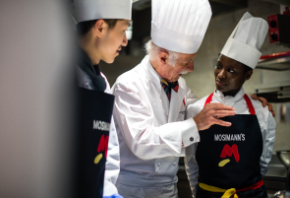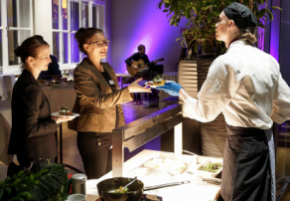- About
- Programs
- Campus Life
- Career Services
- Admissions
- News & Events
- Alumni
Dining Etiquette Rules for Social and Business Meals
Discover essential dining etiquette tips to navigate any meal confidently. Learn table manners for both business and social occasions.
Key Takeaways
- In a standard formal dining setting, every item has a designated place.
- A fork and knife side by side at the four o'clock position of the plate signals the diner is finished eating.
- A napkin on the chair signals that the diner is coming back.
- Dining customs differ greatly around the world, shaped by cultural traditions, religious beliefs, and social expectations.
Knowing dining etiquette is more than just a social skill; it reflects awareness, respect, confidence, and education in both casual and professional settings. Dining etiquette refers to the set of polite behaviors expected at the table. It guides how you interact during meals, how you treat others, and how you carry yourself.
Understanding dining etiquette is essential not only for those enjoying a meal but also for those serving it. For diners, mastering these unspoken rules builds confidence and allows them to focus on the conversation rather than worrying about which fork to use. For servers, it is just as important to understand these details to anticipate needs, serve with discretion, and help guests feel at ease.
What Is Dining Etiquette?
Dining etiquette refers to the accepted behaviors diners and servers follow during meals to show politeness and respect. It plays a key role in how we present ourselves in both personal and professional settings, both formal and informal. Knowing when to start eating and how to use utensils at the table can shape the way others see you.
For example, as a diner, waiting for everyone to be served before picking up your fork shows consideration. In a business lunch, keeping your phone off the table signals attention and respect. These habits may seem small, but they speak volumes and are all part of what we call dining etiquette.
Good dining etiquette makes important meals feel less stressful, even in formal or unfamiliar settings. The point isn't to show off or appear overly polished. It's about being considerate and creating a comfortable atmosphere for everyone at the table.
Table Setting Basics
Understanding the basics of a table setting can help you feel more at ease during formal and casual meals. In a standard formal setting, every item has a designated place.
The plate sits in the center, with the napkin either on top or to the left. Forks go on the left side of the plate, usually with the smaller salad fork on the outside and the dinner fork closer to the plate.
On the right, you'll find the knife, sitting nearest to the plate, with its blade facing inward, followed by the spoon on the outer side.
Glasses are placed above the knife, starting with the water glass and followed by wine glasses if needed. A bread plate, when included, sits above the forks, with a small butter knife resting across it.
Formal table settings include more utensils and glassware, while casual settings keep it simple with just the essentials. Once you know what each item is for, it becomes easier to navigate the meal and focus on the experience rather than the setup.
Start Your Culinary Journey
Learn the art of cooking in a world-class environment
Important Dining Etiquette Rules
These dining etiquette tips are your go-to toolkit for handling meals with confidence, no matter the setting. From using your napkin correctly to choosing wine or handling awkward moments with grace, these habits can help you feel in control.
For culinary arts students, mastering dining etiquette is more than useful; it is essential. How you carry yourself at the table reflects the same level of professionalism expected in the kitchen and beyond. Just as important, when you are on the other side of the table, whether plating a dish or leading a service, you are expected to present the meal and conduct the experience according to established etiquette norms. This attention to detail ensures that diners feel comfortable, respected, and confident in the care they are receiving.
Napkin
As a diner, when your host places their napkin on their lap, that's your cue to do the same. Gently unfold it and place it on your lap; do not shake it open or tuck it into your collar.
During the meal, use the napkin to dab the corners of your mouth lightly when needed. It should never be used to wipe your face or nose. If you leave the table briefly, place the napkin on your chair to indicate to the waiter that you're coming back.
Once the meal is over, loosely fold your napkin and place it to the left of your plate. This small gesture signals to the staff or host that you've finished dining. Proper napkin use shows respect for the setting and the people around you.
Ordering and eating
When it's time to order, be polite and clear with the server. If you have dietary restrictions or preferences, mention them respectfully and briefly. Avoid long explanations or complicated substitutions unless necessary.
Once the food arrives, try to eat at a pace similar to those around you. Eating too quickly or too slowly can disrupt the meal's flow. If you finish first, wait before reaching for your phone or standing up.
To show you're done eating, place your fork and knife side by side at the four o'clock position on your plate. This silent signal to waitstaff helps avoid confusion and keeps the table service flowing.
Polite ordering and mindful eating show that you're aware of your surroundings and considerate of the group. For servers, recognizing visual cues like utensil placement or the pace of a table is part of delivering thoughtful service. Clearing too early or interrupting the flow of the meal can feel intrusive, so being attentive without hovering is key to professional and polished hospitality.
Wine and cocktail menu
In group settings, follow the host's lead when ordering wine or cocktails. If drinks are offered, feel free to politely accept or decline without overexplaining. A simple "No, thank you" is perfectly appropriate. Never pressure others to drink or call attention to their choices.
If you decide to have a drink, always handle wine and cocktail glasses by the stem to avoid warming the drink and leaving smudges. If drinking alcohol, always keep consumption moderate if you are in a business, professional, or formal setting.
For diners, it is customary to accept a clean glass when switching from one wine to another. A trained server should always offer a new glass, and refilling the same glass with a different wine is considered a poor form. For servers, it is essential to anticipate this need and handle glass changes with discretion and grace.
In addition, here are a few dos and don'ts to remember:
Do:
• Sip slowly and with moderation.
• Place the glass back on the table between sips.
• Use coasters if provided.
Don't:
• Wave the glass around when talking.
• Refill your glass without offering others first.
• Swirl or sniff the wine in a showy way unless in a tasting.
In formal settings or as a guest, it is generally frowned upon to serve yourself anything other than water. Wine refills should be offered by the host or the waiter. If you are hosting, always offer to top up your guests' glasses before refilling your own.
Silverware usage
When it comes to silverware usage, the "outside-in" rule helps you know which utensils to use first. Start with the utensils furthest from your plate and work your way in as courses are served. For example, the outermost fork is for your salad, and the next one is for the main course.
Between bites, rest your knife and fork on your plate in an inverted V shape, with the tips of the utensils touching and the handles resting on the edges of the plate. This signals to the server that you are not finished eating.
If you're served a specialty utensil, like a soup spoon or seafood fork, it will usually match the course being served. For example, a rounded spoon for soup or a small fork for shellfish.
Being familiar with silverware placement and usage helps avoid hesitation and keeps the meal flowing naturally.
Conversation and behavior
Good table conversation should be light, respectful, and inclusive. Safe topics include food, travel, books, cultural experiences, or shared events. Ask questions and listen actively, keeping everyone engaged.
Avoid bringing up politics, religion, money, or anything too personal. These subjects can quickly make others uncomfortable, especially in mixed company or business settings.
Do your best not to dominate the conversation or interrupt others. Wait for natural pauses before adding your thoughts. When someone is speaking, avoid checking your phone or looking around the room. Focus on eye contact and body language to show interest.
A balanced conversation makes the meal more enjoyable and helps build positive connections. When it comes to culinary students, being well-mannered at the table supports the same professionalism expected in the kitchen, where communication and respect are key. The best servers are observant and wait for the right moment to approach the table, ensuring that service feels seamless and respectful.
Difficult situations
Dining doesn't always go smoothly, and knowing how to handle awkward moments can make a big difference. Spilling water, dropping utensils, or forgetting which fork to use can happen to anyone; however, these can lead to uncomfortable situations if not carried out gracefully.
For example:
- If you spill something, stay calm and apologize quietly. Blot the area with your napkin and ask a server for help if needed.
- If you're unsure which utensil to use, pause and observe what others are doing.
- If you make a mistake, correct it without calling attention to yourself.
- If you need to leave the table, say "Excuse me" and step away discreetly without announcing personal reasons for leaving.
- If you need to sneeze or deal with food stuck in your teeth, excuse yourself and go to the restroom.
Eating Etiquette for Specific Foods
Different dishes call for different manners. Here's how to handle a few common ones without drawing the wrong kind of attention:
- Soup: Scoop the soup gently away from you and sip from the side of the spoon. Avoid slurping or blowing to cool it down.
- Bread: Break off bite-sized pieces with your fingers. Butter each piece just before eating it, not the whole roll at once.
- Shellfish: Use the provided tools to crack shells carefully, and bring the meat to your plate before eating. Avoid using your fingers unless appropriate for the setting.
- Pasta: Twirl a few strands at a time with your fork. Cutting pasta or using a spoon to assist is usually unnecessary in formal settings.
- Appetizers: When shared, use the serving utensil or offer the plate rather than reaching. Take modest portions.
Dining Etiquette Across Cultures
Dining customs differ greatly around the world, shaped by cultural traditions, religious beliefs, and social expectations. Understanding and appreciating these differences is key to having respectful and enjoyable meals, all while honoring and not overlooking the traditions and beliefs of others.
Western cultures (Europe and North America)
In Western dining traditions, meals often follow a structured format. Utensils are used in a specific order, starting from the outside and moving inward with each course. It's customary to keep hands visible above the table, resting wrists on the edge.
When finished, placing the knife and fork parallel on the plate signals completion. Avoid resting elbows on the table and refrain from making loud noises while eating.
Asian cultures (China, Japan, Korea)
In many Asian countries, communal dining is common, with shared dishes placed at the center of the table. Chopsticks are the primary utensils, and there is specific etiquette associated with their use.
For example, in China, it's considered impolite to point with chopsticks or stick them upright in a bowl of rice. In Japan, slurping noodles is a sign of appreciation, whereas in Korea, waiting for the eldest to start eating before you begin is standard.
Middle Eastern cultures
Middle Eastern dining places a strong emphasis on hospitality and generosity. Meals are often served on a shared platter, and eating with the right hand is customary, as the left is considered unclean.
Refusing food or drink can be seen as impolite; even if you're full, it's courteous to accept a small amount. Complimenting the host on the meal is appreciated, and leaving a bit of food on your plate can signal that you are satisfied and well-fed.
Elevate Your Dining Experience
Mastering dining etiquette both as a diner, a server, or a restaurant owner opens doors to confident, respectful social and business interactions. Key tips include knowing how to use utensils properly, pacing your eating with others, and being mindful of cultural differences. Practicing these skills helps you feel comfortable in any dining setting and leaves a lasting positive impression.
For those who see the culinary experience as more than dining out and want to excel in every detail, including how to elevate the experience for themselves and other diners, Culinary Arts Academy Switzerland (CAAS) programs equip you with the practical skills and professional polish to stand out. Check out our Bachelor of Arts in Culinary Arts, Master of Arts in Culinary Business Management, and Swiss Diploma in Culinary Arts to turn your culinary passion into a satisfying career!
Frequently Asked Questions (FAQs)
What are 10 table manners?
These include sitting up straight, placing your napkin on your lap, waiting for everyone to be served before eating, chewing with your mouth closed, not speaking with food in your mouth, using utensils correctly, avoiding reaching across the table, excusing yourself politely, saying please and thank you, and placing silverware properly when finished.
What dining etiquette should you follow when ordering from the menu?
Be polite to the server, avoid complicated substitutions, follow the host's lead if in a group, and make your order confidently without holding up others.
Is tipping considered part of dining etiquette?
Yes, tipping is expected in many countries and reflects your appreciation for good service. Just be aware that the amount and practice vary by culture.
Interested in studying at CAAS? Download our brochure to learn about our programs!



























